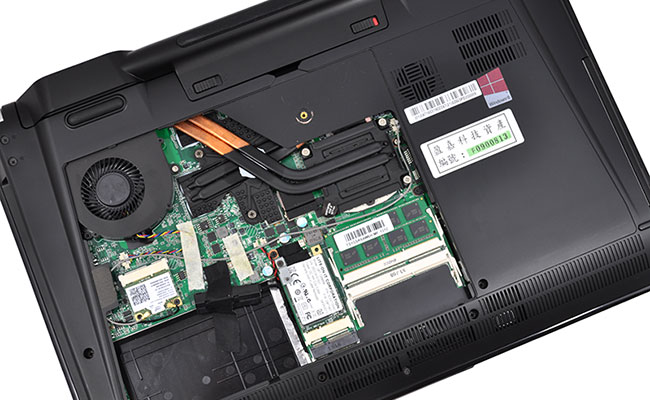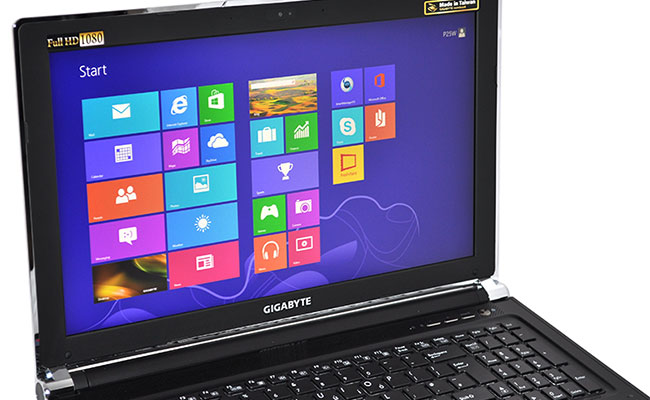Specification
At the heart of the P25W, Gigabyte is pairing a quad-core Intel Core i7-4700MQ processor with dedicated Nvidia GeForce GTX 770M graphics and a full-HD, 15.6in LED display. The Intel chip is a latest-generation 'Haswell' part that offers a maximum frequency of 3.4GHz, hyper-threading, and integrated HD 4600 graphics for use with lighter tasks that don't demand the muscle of the discrete GPU. Courtesy of Nvidia's Optimus technology, the laptop is able to switch between graphics processors automatically as and when needed.
These headline components illustrate the P25W's strengths, and the supporting cast ain't bad, either. Depending on retail configuration, buyers will get either 4GB/8GB of DDR3 memory, a DVD/Blu-ray optical drive, and three storage bays - two mSATA and one SATA - that will be uniquely configured at varying price points.
Our review sample, an entry-level model, came equipped with just a single 128GB LiteOn LMT-128M6M mSATA SSD, but other configurations will ship with dual mSATA SSDs in RAID, as well a spare 2.5in hard disk for storage. Indeed, Gigabyte's product page suggests we'll be seeing a model equipped with dual 256GB mSATA SSDs as well as a 1TB hard disk.
The largely plastic chassis might be lacking the physical quality of various aluminium competitors, but it does have the advantage of being easily accessible. Just one screw needs to be unfastened to gain entry into the laptop's main section, where users will find it easy to add/remove storage, or make use of the second memory slot.
Dual heatpipes are tasked with drawing heat away from the CPU and GPU components, and both lead to dedicated rear vents that form part of the battery assembly. The latter is a sizeable 86.2Whr unit, so we're expecting a decent run when it comes to battery life.
The sound should be better than your average laptop, too, as Gigabyte has shoehorned four speakers into the P25W chassis, as well as a dedicated subwoofer. Elsewhere, we have a generic 1.3 megapixel webcam, integrated Wireless N and Bluetooth 4.0 connectivity, and a 64-bit install of Microsoft Windows 8.
Connectivity, meanwhile, comes in the form of eSATA/USB 2.0, VGA-out and power-in on the laptop's left side, while the right side provides a pair of audio jacks, two USB 3.0 ports, an SD card reader, HDMI-out and a Gigabit Ethernet jack.
Display and Sound
We suspect the P25W isn't going to be left wanting in terms of performance, so it's imperative the display is adept at serving-up whatever the graphics processors dish out. Thankfully, the matte 15.6in panel that Gigabyte is using is well up to the task.
It's worth noting that there are more exotic options in Gigabyte's stable - others in the P-Series range are packing IPS displays - but while the P25W makes do with a more-modest TN panel, this is still one of the better 15.6in screens we've come across.
The matte coating helps keep unwanted reflections at bay, viewing angles are very good - on both the horizontal and vertical planes - and colour reproduction is decent, too. The full-HD, 1,920x1,080 resolution is a must for a laptop of this size, and it's good to see that laptop manufacturers are cottoning on to the fact that pixel density does matter. Gigabyte's display has numerous strengths, though brightness arguably isn't amongst them; the backlit panel is sufficient for indoor use, but you may find it isn't quite bright enough for easy viewing in direct sunlight.
On the audio front, the system's speakers also prove to be solid performers. The quartet of stereo speakers pack plenty of volume, and though the subwoofer ultimately struggles to deliver meaningful bass, the end result is richer than your average laptop.











